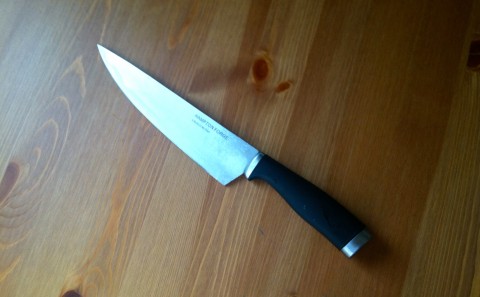
Imagine a world where you couldn’t cut up your food before cooking.
Forget stir-fried veggies. You’ll be eating onions and peppers out of hand like apples and oranges instead.
And that grilled turkey leg you enjoyed so much at the renaissance festival? You’ll have to take it up a notch and eat the entire turkey whole.
Everything would take hours (if not days) to cook in order to heat all the way through, or else your food would be charred on the outside and raw on the inside.
Learning how to wield a knife is the second most important skill you can master when learning how to cook.
(The other skill is heating food, which I covered in last week’s post, if you’d like a refresher.)
Despite what you’ve always been led to believe, cooking is not nearly as difficult as it seems, and mostly relies on you learning a few basic skills that you will use for the rest of your life.
And now that you know the four essential cooking techniques, all you need to learn are the five basic knife skills.
Yes, there are other cutting methods out there, but let’s not complicate things. These five skills will make up 99% of all the knife work you will do for the rest of your life:
- Peeling
- Slicing
- Dicing
- Mincing
- Chopping
With only one exception, you can perform all of these tasks with a chef’s knife, so skip the big expensive set and just make sure you get a good one, which you can find at any store that sells kitchen equipment.
1. Peeling
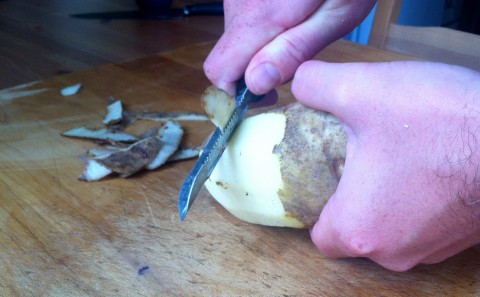
Peeling is simply removing the outer layer of a fruit or vegetable.
This is useful when the outer skin is tough, if you don’t want that texture in the dish you are making, and as a way to “clean off” the outside of the fruit or vegetable.
The best foods for peeling are tough roots and tubers such as potatoes, sweet potatoes, and carrots. But it can also be used for sturdier fruits such as apples and peaches (if you are ambitious enough to cook your fruits into a dessert).
This is the one skill where a chef’s knife is just too bulky.
Sure, you could get yourself a paring knife, but it is much easier (not to mention cheaper) to go with a basic peeler.
To peel, you simply hold the vegetable (or fruit) in your hand and down on a cutting board. Run the peeler down the vegetable away from you and move it around until you get all the outer layer off.
(If you’d like to learn a method to peel potatoes quickly without using a knife or a peeler, then check out my Kitchen Hacking 101 email series!)
2. Slicing
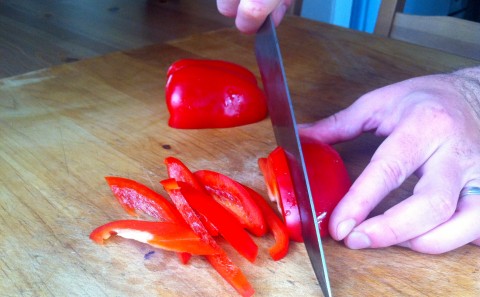
Slicing is cutting food into thin, long slices.
It involves simply making cuts that don’t intersect with one another and can be done with just about any vegetable or fruit you can think of. Common examples include carrots, onions, celery, peppers, and cabbage.
Slicing is the quickest way of cutting up most types of food as it results with the longest pieces. This method may not give you bite-size pieces of food, but they will be thin enough to cook quickly.
How you slice depends on the food, but generally involves pushing the food towards your knife as it slices off pieces.
3. Dicing
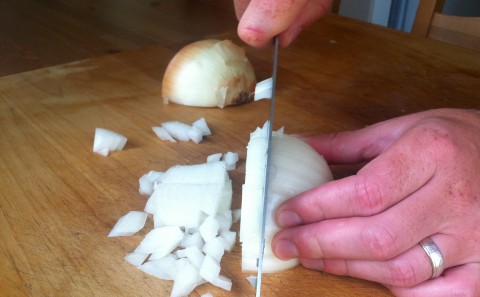
Slice a food. Then slice it again perpendicularly. That’s dicing.
It’s as simple as that.
Dicing will give you large cubes or squares. Not only will these cook quickly, but they are generally small enough to be eaten whole without any additional cooking.
So diced vegetables can be especially useful when in soups and stews, meals that you only want to use a spoon to eat.
Since dicing is so similar to slicing, it can usually be done on the same foods that you would slice. Some common vegetables you might dice include potatoes, peppers, and onions.
Dicing depends on the specific vegetable, but really just involves the following process:
- Slice a vegetable.
- Slice it again perpendicular to the original slice. This will be sufficient if you are dicing a “thin” food, such as peppers.
- If you are dicing a “thick” food such as potatoes, you will need to make one more set of slices perpendicular to the two sets of slices to end up with thick cubes.
4. Mincing
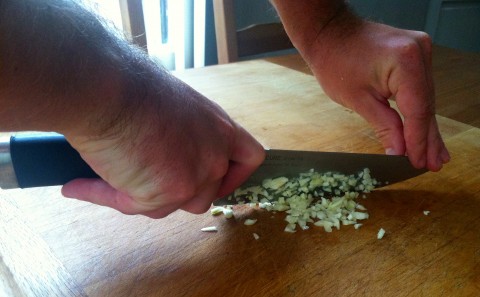
Where slicing and dicing are precise methods of making strips and cubes, mincing is a more fast and loose way of cutting your food into as small of pieces as possible.
Since these small pieces will cook really fast, they will often just “melt” into the dish. There’s really only two vegetables that I can imagine mincing–garlic and shallots–and there’s a good chance you’ll never even use shallots.
If you’re living large in prison, you can go about mincing with a razor blade, but I’d suggest using a chef’s knife.
Here’s what I do to mince:
- Slice the garlic (or shallot) as thinly as possible as I push it toward the blade.
- When the clove is small enough that I can’t hold it steady, I flip it down on the flat side and begin slicing in that direction. I repeat this step until I have sliced the entire thing up.
- Then, I gather the slices up into a pile, and just make small slices through the entire thing several times from different directions until I can tell that everything has been minces into tiny pieces.
5. Chopping
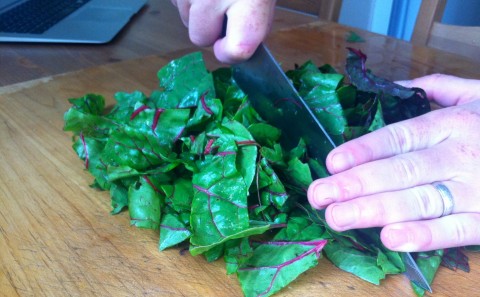
Think of chopping as just larger-scale mincing. You’re just cutting the food up into smaller pieces and not really worrying about their specific shape.
Chopping is usually done on vegetables with less structure than those you would slice and dice.
Things like lettuce, dark leafy greens (chard, kale, collards), and fresh herbs (parsley, cilantro) usually don’t hold up well under cutting, so it’s best to just chop ’em up every which way until they are the size you want.
But lest ye think this is a total free-for-all, here’s how I chop veggies:
- Gather the food together as well as possible.
- Push the food towards your knife and cut as though you were slicing.
- Then gather the slices together in a pile and slice through it a few times from several directions.
The Minimalist Chef
Cooking is often portrayed as an arduous task that is impossible for the Average Time-Strapped Joe to learn.
Nonsense.
When you get down to it, cooking is merely cutting food up and heating it up. And there are just a small handful of skills you need to learn in each of those categories.
For cutting, you only need to know how to peel, slice, dice, mince, and chop before you are able to tackle literally any meal you’d like to prepare at home.
These basic skills are like the “wax on, wax off” that the Karate Kid learned. They might be a little frustrating at first, but once you have them down you can create anything you’d ever want to in the kitchen.
 I'm a science geek, food lover, and wannabe surfer.
I'm a science geek, food lover, and wannabe surfer.
{ 2 comments }
Darrin,
I was kind of intimidated about wielding a knife before I started cooking, but it’s not so bad with a little practice. Love that clip from Goodfellas!
Alykhan
@Alykhan
It’s a classic! 😀
Comments on this entry are closed.